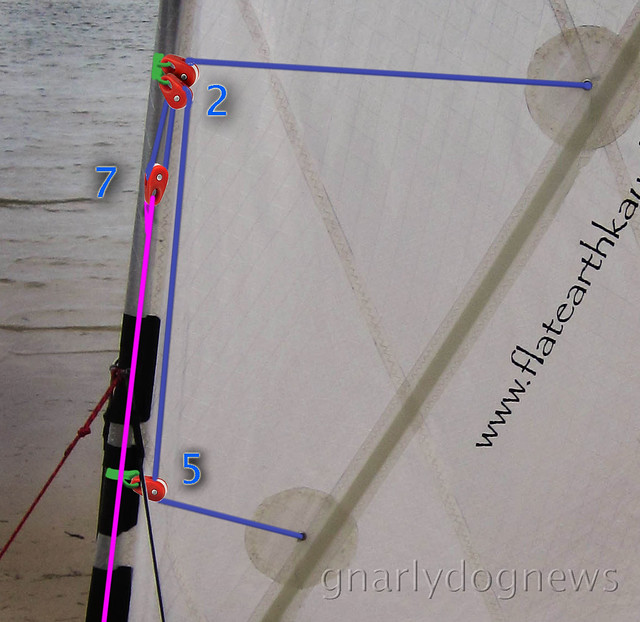It features reefing point to make the sail smaller when the wind is really blowing and a smaller sail is called for.
My solution to reef the sail is simple: two little loops that pull the sail to the mast and reduce the surface area. One drawback: I need somebody to help me with the reefing since I can’t be seated in my cockpit and reach the loops; they are just too far away from me.
Gnarlydog News reader Kris Carlson, a designer from Swansea MA, USA has designed a relatively simple way to reef the Code Zero sail when paddling solo.
Most of his sea kayaking is usually alone and he wants to have the ability to safely reduce the surface area when seated in his kayak.
He sent me some drawings and explanation of his idea.
Here is his concept
 |
| click on image to enlarge |
Above is a composite image of his concept using Ronstan superlight plastic blocks.
Below are the itemized components from Kris:
1. Upper Reinforced Grommet in Sail
2. Upper Double Reef Block
3. Upper Webbing Strap
4. Lower Reinforced Grommet in Sail
5. Lower Reefing Block
6. Lower Webbing Strap
7. Reef System Downhaul Block
8. Mast Base Turning Block
9. Bullseye
10. Clamcleat

Installation:
Webbing straps (3,6) need to be sewn onto the mast sleeve of the sail. A double block (2) needs to be lashed to the upper webbing strap. A block (5) needs to be lashed to the lower webbing strap. A block (8) needs to be lashed to the base of the mast. A bullseye (9) needs to be installed near the edge of the deck to guide the line down the side of the boat. A Clamcleat (10) needs to be installed with-in arms-length of the cockpit. Tie or splice block (7) to the lower reef line. Tie a stopper knot at the end of the upper reef line and pull it through the upper sail grommet (1). Run line through the first sheave on block (2). Run line through block (7). Run line through the second sheave on block (2). Run line down through block (5). Feed line through lower grommet (4) and tie a stopper knot. Feed the lower reef line (now attached to the upper line via block 7) through the mast base block (8). Feed the line through the bullseye (9). Run the line back to the Clamcleat (10) and tie a stopper knot.
Use:
When the reef line passing through the Clamcleat (10) is pulled towards the cockpit, the downhaul block (7) will evenly pull the upper reef line loop towards the deck and collapse the sail up against the mast.
Kris’ concept could be modified to have the Clamcleat removed from the deck and replaced with a suitable cleat on the end of the boom. This variation however might require to have the sail mast lowered (like when stowed) since reefing the sail lifts the boom higher away from the operator. Also, the Ronstan blocks could be replaced by simple stainless steeel rings although some increased friction might occur on the reefing line.
I am sure that some will find this reefing concept too complicated but I am very thankful to Kris for his contribution to this blog; he has find a solution for solo sailors that want to use the reefing on the FEKS Code Zero sails.
.



Looks like a huge sail area for a kayak. Wow.
ReplyDeleteNice solution: the lower reefline will pull the bottom part of the batten to the mast first. If you keep pulling the line from the cockpit the upper reefline will follow. Very smart. It's always tricky to run a line through several blocks, causing a delay somewhere. One part might run faster than the other. But this works just right. Chapeau!
ReplyDeleteWhile the theory seems solid, I have never actually install such system on any of my sails. Admittedly a 1 square meter of sail is indeed a bit much for anything above 10knots
Delete